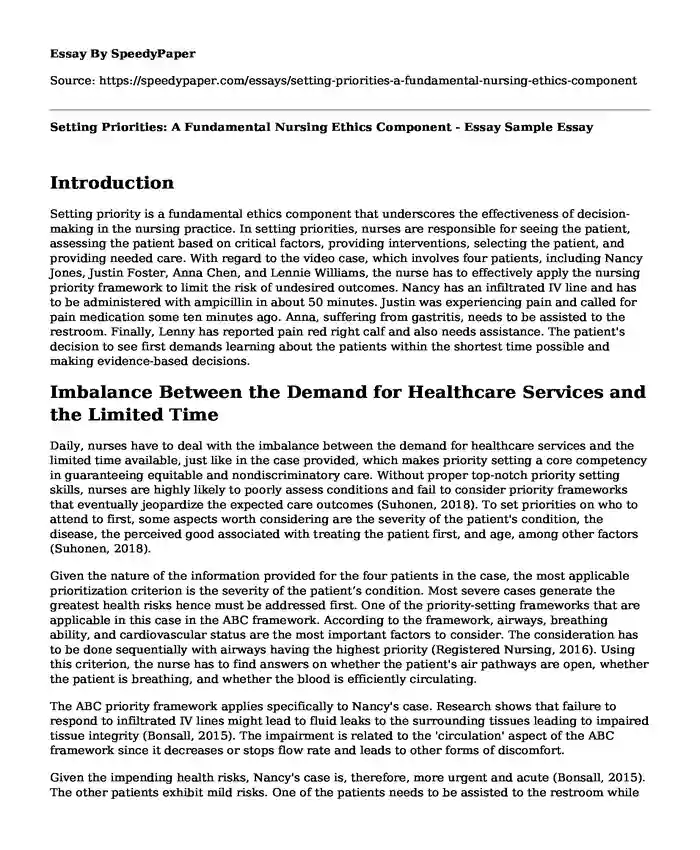
| Type of paper: | Essay |
| Categories: | Nursing Medicine Healthcare |
| Pages: | 3 |
| Wordcount: | 701 words |
Introduction
Setting priority is a fundamental ethics component that underscores the effectiveness of decision-making in the nursing practice. In setting priorities, nurses are responsible for seeing the patient, assessing the patient based on critical factors, providing interventions, selecting the patient, and providing needed care. With regard to the video case, which involves four patients, including Nancy Jones, Justin Foster, Anna Chen, and Lennie Williams, the nurse has to effectively apply the nursing priority framework to limit the risk of undesired outcomes. Nancy has an infiltrated IV line and has to be administered with ampicillin in about 50 minutes. Justin was experiencing pain and called for pain medication some ten minutes ago. Anna, suffering from gastritis, needs to be assisted to the restroom. Finally, Lenny has reported pain red right calf and also needs assistance. The patient's decision to see first demands learning about the patients within the shortest time possible and making evidence-based decisions.
Imbalance Between the Demand for Healthcare Services and the Limited Time
Daily, nurses have to deal with the imbalance between the demand for healthcare services and the limited time available, just like in the case provided, which makes priority setting a core competency in guaranteeing equitable and nondiscriminatory care. Without proper top-notch priority setting skills, nurses are highly likely to poorly assess conditions and fail to consider priority frameworks that eventually jeopardize the expected care outcomes (Suhonen, 2018). To set priorities on who to attend to first, some aspects worth considering are the severity of the patient's condition, the disease, the perceived good associated with treating the patient first, and age, among other factors (Suhonen, 2018).
Given the nature of the information provided for the four patients in the case, the most applicable prioritization criterion is the severity of the patient’s condition. Most severe cases generate the greatest health risks hence must be addressed first. One of the priority-setting frameworks that are applicable in this case in the ABC framework. According to the framework, airways, breathing ability, and cardiovascular status are the most important factors to consider. The consideration has to be done sequentially with airways having the highest priority (Registered Nursing, 2016). Using this criterion, the nurse has to find answers on whether the patient's air pathways are open, whether the patient is breathing, and whether the blood is efficiently circulating.
The ABC priority framework applies specifically to Nancy's case. Research shows that failure to respond to infiltrated IV lines might lead to fluid leaks to the surrounding tissues leading to impaired tissue integrity (Bonsall, 2015). The impairment is related to the 'circulation' aspect of the ABC framework since it decreases or stops flow rate and leads to other forms of discomfort.
Given the impending health risks, Nancy's case is, therefore, more urgent and acute (Bonsall, 2015). The other patients exhibit mild risks. One of the patients needs to be assisted to the restroom while the other two are experiencing pain. Although these patients' needs also require addressing, they are less urgent than the infiltrated IV line.
Conclusion
In conclusion, setting priority in the nursing practice is a fundamental aspect of care that demands exceptional understanding and applicability in an attempt to guarantee optimum patient outcomes and satisfaction. As discussed in the analysis, the consequences of failing to prioritize patients by their immediate need for care might be dire and place nursing practice into question. In the case provided, the nurse requires to master and understand the priority-setting framework to ensure that she sets her priorities right. Nurses get to efficiently address patients' needs through priority setting as and when they arise, depending on their urgency.
References
Bonsall, L. (2015). Complications of peripheral IV Therapy. Lippincott NursingCenter | Professional Development for Nurses. https://www.nursingcenter.com/ncblog/february-2015-(1)/complications-of-peripheral-i-v-therapy
Registered Nursing. (2016, July 1). Establishing priorities: NCLEX-RN. RN Programs - Registered Nurse. https://www.registerednursing.org/nclex/establishing-priorities/
Suhonen, R., Stolt, M., Habermann, M., Hjaltadottir, I., Vryonides, S., Tonnessen, S., Halvorsen, K., Harvey, C., Toffoli, L., & Scott, P. A. (2018). Ethical elements in priority setting in nursing care: A scoping review. International Journal of Nursing Studies, 88, 25-42. https://doi.org/10.1016/j.ijnurstu.2018.08.006
Cite this page
Setting Priorities: A Fundamental Nursing Ethics Component - Essay Sample. (2023, Sep 17). Retrieved from https://speedypaper.com/essays/setting-priorities-a-fundamental-nursing-ethics-component
Request Removal
If you are the original author of this essay and no longer wish to have it published on the SpeedyPaper website, please click below to request its removal:
- Free Essay Sample on Steroid Use in Sports
- Comparison Essay Sample: Healthcare System in the U.S. and Japan
- Proposal Policy for the Purpose of Marijuana - Paper Example
- Essay Sample on Diet and Mental Disorder
- Essay Sample on a Contemporary Healthcare Issue
- Essay Example: Leveraging Informatics in the Health Sector
- Paper Example on Covid-19: Global Disruption of Education Affects 1.6 Billion Learners
Popular categories




